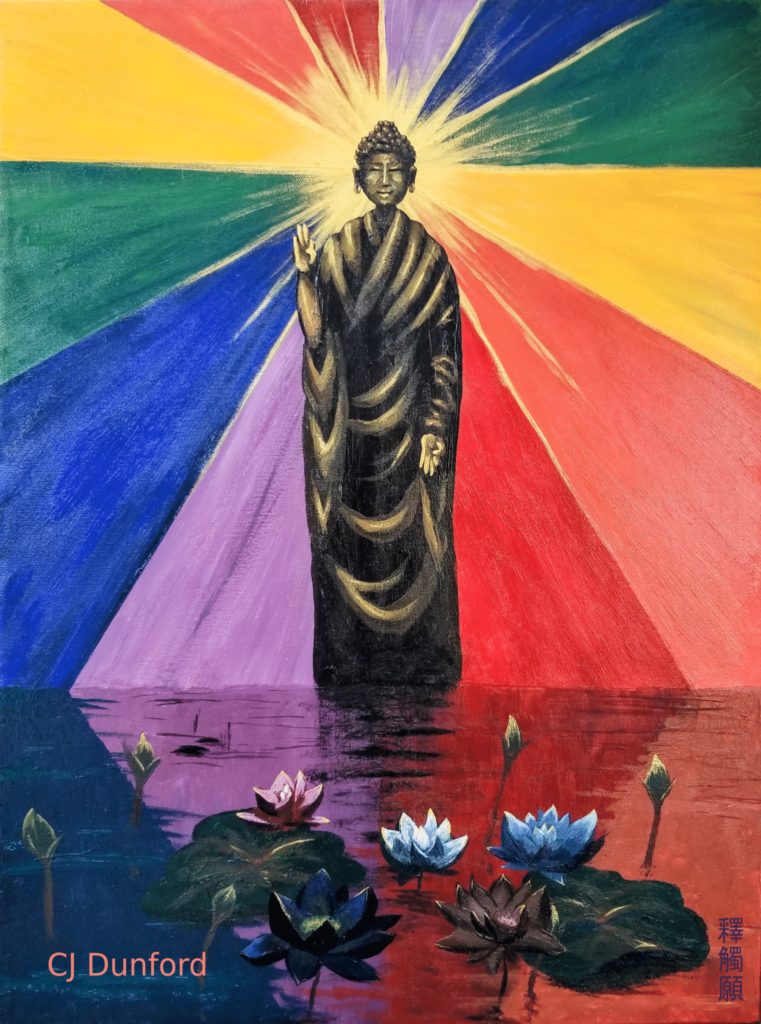This month at the Institute of Buddhist Studies, we wish to celebrate gay pride by highlighting the scholarship of our LGBTQ+ students and faculty, as well as queer theory and queer theology in the wider Buddhist world. We are celebrating both “queerness” in its most basic definition, that is, as a descriptor of people whose sexual orientation or gender identity fall outside of societal norms, but we are also celebrating the act of queering itself. Many of the essays published this month hope to queer Buddhism, by using Buddhist doctrine, iconography, and community in creative ways, in ways that subvert or overturn longstanding patterns in Buddhist ways of thinking. Read our introduction to this special collection here.
In March, Wendy Arce dean of students at the Graduate Theological Union (GTU) asked if I would be willing to give the invocation for our graduating class of 2021 on the GTU’s commencement website. I felt so honored by this request, but was also a bit overwhelmed, juggling lots of different obligations. At first, I just thought this was another task for me to have to worry about, but after thinking about it for a few days, I agreed.

The past year has been unusual, painful, frustrating, and scary for all of us.For me, most of these feelings stemmed from the COVID-19 pandemic and the spiraling events around it.Last year helped to expose, yet again, the abattoir of inequity buried beneath the facades of justice, democracy, and freedom in the US and abroad.Part of me couldn’t help but hope that the chaos of last year would be the first step in addressing underlying problems of racism and oppression, like removing a dirty bandage from a wound.
With all these thoughts tumbling around in my head and thinking about writing an invocation during a celebration of hard work, scholarship, and achievement, I was reminded of the hope offered by imagination. The act of creation and doing things differently, of creating a new society outside the one in which we live, is the very foundation of Pure Land Buddhism. Bodhisattva Dharmakara’s vows to create a Pure Land in which all beings can be born, where life is easy and we can focus on enlightenment together is this act of the creative imagination, and this was my inspiration for my invocation. I realized that Amida Buddha’s Pure Land of Sukhāvatī had inspired my own path in Jōdo Shinshū Buddhism, and that the best way for me to honor this moment was to draw upon my own identity as a queer, transgender Jōdo Shinshū Buddhist to express my own appreciation of the Pure Land. From this, I created my painting “Limitless Love.”
The act of creation and doing things differently, of creating a new society outside the one in which we live, is the very foundation of Pure Land Buddhism.
I was also inspired by some lotus drawings made by Kodo Nishimura, a queer makeup artist and ordained Jōdo Shū minister from Tokyo. During a panel I attended several months ago, Nishimura shared his own queer Pure Land Buddhist artwork, and that helped me to make my own connections to the beauty of Amida’s Pure Land of Sukhāvatī and the beauty of our diversity and individuality.
Viagra Generiek kopen zonder recept in apotheekIn the Sutra on Amida Buddha, Shakyamuni Buddha describes Sukhāvatī in vivid detail to his disciple Śāriputra:
Again, Śāriputra, in the Land of Perfect Bliss there are many pools of seven kinds of jewels, full of water with the eight excellent qualities. The bottoms of the pools are covered entirely with sands of gold. On the four sides of the pools, there are stairways made of gold, silver, lapis lazuli, and crystal. Multistoried pavilions, majestically adorned with gold, silver, lapis lazuli, crystal, sapphire, red pearl, and carnelian stand alongside the banks. There are lotus flowers, as large as chariot wheels, growing in the pools. Those of blue color emit blue radiance; those of yellow color emit yellow radiance; those of red color emit red radiance; and those of white color emit white radiance. They are exquisite, wonderful, fragrant and pure. Śāriputra, the Land of Perfect Bliss is filled with such splendor and adornments.
Though there is more detail about the appearance of Sukhāvatī in the sutra, this particular passage speaks of the uniqueness of each lotus and how beautiful they all are, and this description made me think of our own uniqueness as individuals. In Buddhism, sentient beings who aspire for awakening are often compared to a lotus bud that grows from the mud and water in a pond, and our enlightenment is the blooming of the lotus.

The research I did for my thesis was centered on understanding Jōdo Shinshū Buddhism from a liberative queer perspective, and so I thought for my invocation, I would like to turn my thesis work into a painting. I thought to myself: “Let’s paint the Pure Land, but make it hella queer!” I decided to use Daniel Quasar’s “Progress Pride Flag” redesign and the above passage from the Amida Sutra as inspiration, and this is the painting that I came up with.
Later, someone asked me if I thought the Pure Land was really full of rainbows, and I said: “Absolutely!” As we celebrate LGBTQIA+ Pride month, I hope we can all find rainbows in the Pure Land. Buddhism in the United States involves so many identities, be they aspects of culture, religious background, race, sexuality, or gender. They’re all intersectional, and a rainbow-clad Pure Land is one way of including all those beautiful parts of who we are as Buddhists in our sanghas.